You might have heard about business owners who are leveraging the LinkedIn Sales Navigator for their lead generation effort.
Well, social selling has revolutionized the sales environment, making it easier than ever to engage with prospects and naturally uncover leads and LinkedIn has become a standard social platform for individuals in a variety of sectors to locate and cultivate sales leads.
Also, it has a powerful tool that can help enable sales professionals to establish contacts and close transactions.
Interesting, right?
LinkedIn launched Sales Navigator last July 31, 2014. In the nine years after its introduction, the tool has proven to be invaluable to sales teams.
And it’s not surprising why.
LinkedIn generates 277% more leads than Facebook or Twitter.
It gives sales firms even more power to find prospects and manage their pipelines.
The merchant receives data on their lead and account activity, which they may use to tailor their outreach.
But how would LinkedIn Sales Navigator really assist you in generating leads?
In the next sections, we’ll look at the technicalities and provide you with practical guidance and ideas on how to use it effectively.
Exactly, we aim to show you how to stand out from the matches.
What is Sales Navigator?
LinkedIn offers both free and premium options.
However, Sales Navigator is a paid service on LinkedIn that helps businesses create leads by allowing you to effortlessly locate your target audience and connect with them in just a few clicks.
It is characterized as the ideal version of LinkedIn for anybody interested in sales prospecting, owing to its many features specifically built for this purpose.
Sales Navigator, which comes in three editions (Professional, Team, and Enterprise).
Truth be told, is not economical, particularly for small business owners.
On the other hand, LinkedIn provides a 30-day free trial to let you decide whether the service is worthwhile or not.
However, with Sales Navigator, you’ll receive far more advanced search criteria, resulting in a considerably higher quality list of possibilities.
This indicates that your prospect list is of higher quality, which should lead to more success.

How Does it Work?
LinkedIn’s main product for sales teams is Sales Navigator, which enables representatives, managers, and operations leaders to inform their approach and goals by accessing LinkedIn’s massive data, insight, and relationship-building capabilities.
It also delivers all of the prospect information that sales professionals need.
Moreover, it saves that knowledge and any additional information prospects give over time as an individual or target account.
Yes, you heard it right.
Fortunately, negotiators may now reach out to new leads with whom they are not yet directly associated using Sales Navigator.
For emphasis, this tool gives salespeople greater opportunities to locate and interact with leads outside of their local network.
The option to utilize sophisticated searches, store leads, build custom account lists, and add notes or tags to leads and accounts simplifies salespeople’s pipeline management and ensures nothing goes through the gaps.
Ultimately, these premium search filters save representatives time by assisting them in targeting the most relevant connections, allowing them to focus on more critical sales duties such as relationship development and deal closing.

7 Tips to Generate Leads with Sales Navigator
Everyone always has the same question when we talk about LinkedIn Sales Navigator.
Is it worthwhile?
To answer that, go over the top seven techniques to grasp it quickly.
Tip #1: Create a Strong Profile
Your LinkedIn profile provides the initial impression of you and your company.
It is like your online résumé, so keep it thorough and up to date.
Your profile should be professional and entertaining, as it is the first thing people see when they visit your page.
That is why you should maintain your profile active.
Ensure your profile photo is of great quality, and that your title is clear and simple.
Your summary should highlight your abilities and expertise while also giving potential leads a sense of what you can offer them.
Tip #2: Establish quality connections
Before you use LinkedIn Sales Navigator, you need to identify your target demographic.
Determine precise criteria such as the industry, job title, business size, and location.
This will allow you to utilise the advanced search options more successfully.
Besides expanding your knowledge, join LinkedIn groups relating to your sector and engage in conversations.
However, it is critical to remember that creating a network is about more than simply the quantity of connections; it is also about the quality of these connections.
Why? Because quality connections are the foundation of a strong LinkedIn network and this includes a sense of mutual support.
So, how can you achieve this?
Engage to your connections’ post by giving insights and comments to their posts.
Tip #3: Create compelling and relevant posts
Creating interesting material is necessary for gaining leads using LinkedIn Sales Navigator.
The content of your piece should be relevant, helpful, and useful to your intended audience.
You may share blog entries, articles, and industry updates.
In addition, you may also develop your subject matter, such as infographics or films, to demonstrate your expertise and engage your target audience.
It is always the key to demonstrating what you can do to aid them in using your products or services.
However, never think that you are writing for all of your connections or followers.
Consider just those who have been lately active on LinkedIn.
They are the people who will most likely view your post when you click ‘publish.’

Tip #4: Be involved with your audience
As mentioned above, you need to stay engaged on LinkedIn by responding to thoughts and information from your network. Like, comment, and share related content.
It does not just keep you in touch with your contacts but also presents you as an industry expert.
When your prospects witness your participation, it might help to develop credibility.
So, how does Sales Navigator works smartly?
It begins by evaluating your platform activity and interactions to determine the sorts of profiles you most regularly see or save.
This activity helps it understand your interests and the types of leads you’re looking for.
Furthermore, it is a continuous learning and refining process.
As a result, your interactions with the proposed leads contribute to their awareness of your preferences, increasing the relevance of future suggestions.
Sales Navigator also provides proactive alerts and updates about possible leads, ensuring you are constantly aware of prospects, even when you are not signed in.
Tip #5: Save your searches
Bookmark your search parameters so you can easily access the results in the future.
Use tags and notes to categorize your prospects depending on their attributes, interests, or positions in the sales funnel.
This allows you to stay on top of mind with possible consumers.
After you save a search, you will receive weekly emails with updated results for that search.
Additionally, alerts for new results from stored lead searches will be displayed on the Sales Navigator homepage under the All Alerts tab.
Saved searches not only save time and effort when looking for leads and accounts on Sales Navigator, but they also significantly increase the number of leads and opportunities for your organization.
Tip #6: Take advantage of InMail Properly
It has been claimed that InMails has open rates of over 85%, with clickthrough rates of up to 5% (Neal Schaffer, 2021).
InMail is a useful function in Sales Navigator that allows you to send messages to LinkedIn members outside of your network.
It is a direct and customizable (paid) mail type on LinkedIn that allows you to communicate with anyone on the platform directly.
How is this different from standard LinkedIn messaging?
When utilised effectively, InMails are reported to have a significantly higher open and response rate than cold messaging/calling or cold emailing.
Right, InMails might be the outreach strategy you need!

Tip #7: Follow Up with Your Leads
Follow-up with your leads is critical for converting them into customers.
So, reach out to them with tailored messaging, add value, and address their problem spots.
Just for emphasis, reach out to them with tailored messaging.
Also, when sending connection requests, avoid using generic messages.
Create unique connection requests that explain why you want to connect and how you can add value to the prospect.
A tailored approach enhances the probability that your connection request will be accepted.
This will assist you in establishing trust and a relationship with them.
Conclusion
The LinkedIn Sales Navigator is a big help for businesses trying to find leads. It started in 2014 and has been really useful for sales teams looking for good ways to find potential customers.
Importantly, LinkedIn is much better at generating leads than Facebook or Twitter, outperforming them by 277%.
Sales Navigator, available in Professional, Team, and Enterprise editions, provides a premium service tailored to enhance sales prospecting efforts.
Its core function lies in tapping into LinkedIn’s extensive data, insights, and relationship-building capabilities.
A standout feature is the ability to connect with new leads beyond one’s immediate network, expanding engagement possibilities.
While the tool comes at a cost, a 30-day free trial allows businesses to test its efficacy. The investment proves worthwhile, offering advanced search criteria that result in higher-quality leads and increased chances of success.


